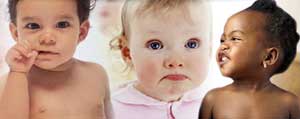Congenital Adrenal Hyperplasia (CAH) Causes Many Children to Be Born with Sexual Development Disorders, Gender Dysphoria, or Signs of Aging
Mistaking Girls for Boys
 |
|
(Photo: mybaby) |
Dr. Nguyen Thi Hoan, Head of the Endocrinology – Metabolism – Genetics Department at the Central Children’s Hospital, reported that CAH is a type of congenital disorder related to adrenal hormones.
Children with CAH experience a hormonal imbalance in the adrenal glands, resulting in a lack of Cortisol (a hormone that maintains blood sugar levels, helps the body cope with stress, and boosts immune function) and Aldosterone (a hormone that regulates salt metabolism, ensuring blood volume and blood pressure stability), while having an excess of Testosterone (a male sex hormone that develops male secondary sexual characteristics), leading to masculinization of the external genitalia.
In newborn boys, the male genitalia may appear larger than normal and take on a darkened color. “There are even cases where baby girls, just three hours after birth, show signs of their genitalia being transformed into that of a boy. This has led their parents to mistakenly name them as boys,” Dr. Hoan provided as an example.
One case at the Central Children’s Hospital is a 14-year-old girl (name withheld) from Hai Phong, who was diagnosed with CAH when her body exhibited 90% female characteristics and 10% male characteristics (the penis transformed into a clitoris but without testicles). By the age of six, she had undergone two surgeries on her clitoris.
However, there are also cases where late diagnosis makes treatment to restore the correct gender difficult. This is true for a girl named N. (born in 1991 in Ha Tay). Although she has a feminine face, N. has developed facial hair and a physique resembling that of a boy. This has made her appear shy and withdrawn, lacking confidence when interacting with others.
Early Surgery and Lifelong Medication Required
|
What is the Probability of Having This Condition? Dr. Vu Chi Dung, Deputy Head of the Endocrinology – Metabolism – Genetics Department at the Central Children’s Hospital, stated that one in 14,000 people is diagnosed with CAH. If a couple has one or more children with the condition while neither parent is affected, the probability of their future children having CAH is one in four. If one person with CAH marries someone without the condition, the chance of their children having CAH is very low, around one percent. However, if two individuals with CAH marry each other, all of their children will have the condition. |
For girls diagnosed with CAH, early detection is crucial to restoring their gender. Dr. Hoan advises that by the time the child reaches adulthood, it becomes very challenging to perform surgery due to the legal framework around gender transition in Vietnam.
Additionally, surgery should ideally occur before the child reaches preschool age to prevent psychological trauma and feelings of inadequacy. Therefore, the best time for gender restoration surgery is when the child is between 4 to 12 months old.
“Girls with CAH who receive timely surgery and treatment can return to a normal life, and they can even marry and have children,” Dr. Hoan stated. However, the challenge remains in how to detect the condition early, as CAH is not a common disease, and local hospitals often lack the capability to diagnose it promptly.
Among the children with CAH at the Central Children’s Hospital is a boy named Nguyen Van Th. (born in 1994 in Hoai Duc – Ha Tay), who appears frail and aged, with wrinkled, grayish skin. Holding her child in her arms, Ms. Binh (Th.’s mother) cried as she recounted: “With this condition, he eats so much, but his body develops like an old man. His mind is slow; even at 12 years old, he is only in the third grade. My family is too poor to afford the treatment for him. When we run out of medication, he suffers from low blood pressure and continuous vomiting.”
Dr. Hoan noted that boys with CAH tend to enter early puberty sooner than normal. Some growth phenomena that should occur during childhood do not manifest, leading to limited height in these patients as they grow older.
Dr. Hoan emphasized that CAH is a lifelong condition with no cure. Enzyme replacement or surgeries on the brain or adrenal glands will not provide any benefit.
However, hormone deficiencies can be managed through lifelong medication, even when the child is completely healthy. There is no need for dietary restrictions with CAH: girls usually require surgery to restore the genitalia to a normal shape and size, while boys do not need such procedures.
A positive development for families with CAH patients is that at this conference, the CLAN organization (Friends of CAH) from Australia will continue to collaborate with doctors at the Central Children’s Hospital and the CAH support group to find long-term, cost-effective solutions for families to obtain necessary medications for their children.
|
About 400 Children in Vietnam Have Congenital Adrenal Hyperplasia This figure was presented at the CAH support group conference organized by the Central Children’s Institute in collaboration with the CLAN organization (Australia) over two days (June 5 and 6) in Hanoi. Many CAH patients were also invited to attend the conference. With this number, Vietnam is considered one of the countries with a high rate of congenital adrenal hyperplasia worldwide. This is a rare condition, with a frequency of 1 in 14,000. |


















































